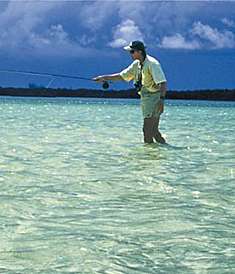|
Learning To Fly
 Near or far, the fly rod can take you to special places, and pure fishing is a sport you can follow into old age. Near or far, the fly rod can take you to special places, and pure fishing is a sport you can follow into old age.
By Joe Doggett
Lionel trains, Daisy BB guns
and Schwinn bikes were the big gifts for junior-high swashbucklers
during the Christmas of 1960. Fly rods were not high on the wish
list.
But that's what I wanted-a
Shakespeare 8-weight Wonder Rod. I saw one on the rod rack at
the Oshman's store in Houston. It was a top quality rod, with
a cigar-shaped cork grip, trim red wraps and a distinctive spiral
finish on the white fiberglass blank. It cost $18.95, a chunk
of change back when a dollar meant something. World-class anglers
like Joe Brooks or the great A.J. McClane would be proud to wield
such a rod, and such a gift seemed out of reach.
Santa came through. Boy, was
I stoked.
The two-piece, 8-1/2-foot Wonder
Rod was propped under the tree that bright morning. And, during
the next 15 years, the same rod was propped under hundreds of
other trees on the banks of the many ponds and streams that helped
form a lifelong passion for fly fishing.
I learned to fish with that
rod. This was before specialty shops and videos and casting clinics.
You just stood in the front yard and flexed your Keds and flailed
away with a level 8-weight line (weight-forward tapers were far
too expensive) until your act more-or-less came together. The
occasional diagrams and illustration in Field & Stream and
Outdoor Life were more confounding than helpful ("McClane
Shows how to Double-Haul in Six Easy Steps"). Invariably,
by easy-step three or easy-step four, the whole thing unraveled
amid a sweaty rubble of misspent line.
My technique remains flawed,
bastardized by too many awkward interpretations on the Hermann
Park duck pond. But it works. At times, I actually look pretty
good; that's less of a brag than the simple fact that if you labor
at a specific task for almost 40 years you must become proficient.
Either that, or quit.
Texans today turn to fly rods
for various reasons. Many Lone Star anglers pick up the long rod
as an alternative, a change of pace to the established techniques
of casting or spinning; in short, they are looking for a fresh
kick on familiar water (especially when "familiar" might
be substituted for "stale"). How many two-pound largemouth
bass can you catch on Carolina-rigged worms on 15-foot mainlake
humps before the drill becomes routine, even boring. Dropping
a bass bug alongside a green shoreline adds a fresh charge to
the day. Same fish, same lake-but a new mood and a different challenge.
This was not my case with the
gift rod. I did not have enough experience for any angling technique
to seem old or dull. Any bass by any method was a big deal for
a 14-year-old city kid with limited access to even marginal water.
I was fascinated by fly fishing not because it looked stylish,
but because it seemed an effective way to cover shallow ponds.
This assumption was absolutely correct.
The 8-weight Wonder Rod became
my main battery for bass and panfish whenever the long shadows
were across the short waters. The soft presentation of a small
popper or bug (or, semi-cheating, a 4-inch unweighted Creme plastic
worm) was natural. And fun.
continued
page 1 / page 2
| 




